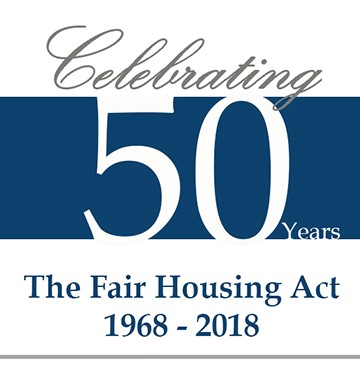Since this post is about Fair Housing Month and the 50th Anniversary of the Fair Housing Act, it seems obligatory to make a statement about how far we have come, but how much work remains to be done?
50th Anniversary Of The Fair Housing Act—The Road Is Long, Let’s Make Sure It’s the Right Road
Since this post is about Fair Housing Month and the 50th Anniversary of the Fair Housing Act, it seems obligatory to make a statement about how far we have come, but how much work remains to be done. On the other hand, if you have been driving on the road for a long time, and you still have a long way to go, it bears asking the question if you are on the right road.
The goal of the Fair Housing Act was not only to end overt housing discrimination, but also to overcome historic patterns of segregation, achieve balanced and integrated living patterns, promote fair housing choice, and foster inclusive communities. Those were some pretty lofty goals.
So, just how far have we come in achieving those goals? Black or African American homeownership rates are now roughly the same, just over 41 percent, as they were before the Fair Housing Act was passed in 1968.(1) Meanwhile, the homeownership rates for other groups has continued to climb, for example, the rate for non-Hispanic Whites is over 72 percent.
Nationally, our communities continue to be segregated. The average White person lives in a neighborhood that is 75 percent White and 8 percent African American, while the average African American lives in a neighborhood that is only 35 percent White and 45 percent African American.(2) The Lexington Fair Housing Council’s recent study of segregation patterns in Lexington, Kentucky, showed that the city of Lexington is becoming increasingly divided with increased concentrations of the population living together based on race and income.(3) The Metropolitan Housing Coalition’s 2017 State of Metropolitan Housing Report shows that the African American population is heavily concentrated in West Louisville, while the majority of the White population lives in East Louisville. The report also shows that there is a very strong overlap between areas with heavy concentrations of African Americans and heavy concentrations of subsidized housing.(4)
Why don’t African Americans typically live near Whites? Has the Fair Housing Act already achieved its goals of creating inclusive communities and fair housing choice, and a large segment of the population has simply replied, “No thanks, everyone is good where they are”?
When I talk to white friends about what they’re looking for when they decide where to live, I hear mainly the same things: good schools, safety, walkable areas, a healthy environment, close to amenities and quality food choices, and access to shopping. When I ask white people why they think African Americans live in the communities they do, I hear very different answers: people want to live where they feel most comfortable, people want to be among their own kind, people want to live near their family and friends. Other people I talk to will attribute the segregation patterns entirely to economics, even though census mapping shows that poor African Americans are concentrated in different areas than their white counterparts.
"After 50 years of segregation, we seem to have accepted how things are, because it seems like that is how things have always been."
I imagine that segregation was a lot easier to explain in 1968. African American families were not living in the same communities as white families because government and society was working very hard to keep them out of those areas. Multiple generations had used every means at their disposal (city ordinances, covenants, deed restrictions, lending guidelines, Realtor steering, social pressure, etc.) to make sure blacks and whites lived in separate areas so as to “prevent conflict and ill feeling.”(5)
After 50 years of segregation, we seem to have accepted how things are, because it seems like that is how things have always been. Americans of every generation know that African Americans have been concentrated in separate neighborhoods as far back as anyone can remember. These racially segregated neighborhoods, however, did not organically happen over time because of personal preferences. They were created through a systemic process to isolate wealth and opportunities for one race over another.
Think about a game of Monopoly, where one group of players has been playing the game for multiple rounds and has bought up most of the property. Now a second group joins the game, and they start out with the same $1,500 that everyone else got when they started. But most of the second-generation players are headed for bankruptcy, as they will soon be unable to continue to pay the rent due to the first-generation players who hold all the property.
Is the game fair? The rules are being enforced the same for both the first- and second-generation players – so in that way the game is fair. However, as the game plays out it soon becomes clear that those rules only enhance the benefit the first generation of players received from starting the game early. There will, of course, be some first-generation players who have bad luck and wind up losing. There might be a few second-generation players who play the game strategically, have good luck, buy some of the remaining property, get good chance cards, and wind up doing well. But clearly the game is rigged against the second generation of players who are set up to fail, while preserving and increasing the gains made by the first generation of players.
How would you fix the game to make it fair to the second generation of players? Should we even try to fix it? Or do we just acknowledge that the game is not set up to be fair, and that some players will constantly be at a heavy disadvantage -- a disadvantage that will actually get worse as the game goes along?
Are we on the right road? This is the national conversation that we need to be having for Fair Housing Month. What is our goal – where should the road take us? Do we need to try a different path? Do we even care anymore?
In our attempts to create equal opportunity, we have gone down a number of roads. The Fair Housing Act made housing discrimination illegal, and there are currently multiple agencies throughout Kentucky that help enforce the Fair Housing Act.(6) But even if we were able to ensure that no one ever again discriminated against another individual because of their race, strict enforcement of those rules would not fix the legacy effects of past discrimination. The second generation of players are still much less likely to succeed, even though the rules are being enforced the same for everyone.
We tried forcibly integrating our schools after Brown v. Board of Education, but it sometimes led to unintended consequences—white flights to the suburbs and parents taking their children out of public schools. We also saw many African American communities struggle after integration, as a few African Americans were now able to move to areas with more opportunity, but no new opportunity moved into the African American communities. In the end, these measures may have inadvertently compounded the concentration of poverty and race in our cities.
"We now are looking at the idea of trying to “Affirmatively Further Fair Housing” within our communities. The goal for this movement is to make us think about whether or not our current policies are inadvertently compounding the legacy problems of the past."
We now are looking at the idea of trying to “Affirmatively Further Fair Housing” within our communities. The goal for this movement is to make us think about whether or not our current policies are inadvertently compounding the legacy problems of the past. If we have $2 million to create more affordable housing, do we simply build it in the parts of the city where we can create the most units? If we follow that policy, we may continue to increase concentrations of race and poverty that were set in motion by the discriminatory practices of the past. However, if we build our affordable housing in areas of high opportunity, we may not be able to afford as many units. These are complicated questions that do not have clear answers.
The goal of “Affirmatively Furthering Fair Housing” is not to require any one specific answer to these questions. The goal is not to have the government socially engineer cities. Rather, the goal is to consider whether or not our current actions are feeding into patterns of past discrimination and making things worse. When we look to develop new affordable housing units, perhaps we should consider the things that everyone else considers when they are looking for a home: What are the schools like? Is it a safe area? Is it a healthy environment? Is it close to quality food choices? Can we afford it?
Maybe “Affirmatively Furthering Fair Housing” is the right road to get us to our desired destination. Maybe there is a better path. As we look back at how far we have come over the past 50 years, it’s okay to acknowledge that we may not be getting very far very fast, but, we need to make sure that we are on the right road.
What changes have you seen along this long road?
How can you help ensure we are on the right road to create fair housing choice and inclusive communities?
Upcoming Fair Housing Month Events in Kentucky
April 24, 2018, 11a.m. – 1:30 p.m. CDT
Free Fair Housing Luncheon and Training at the Robert Cherry Civic Center, 2701 Park Avenue, Paducah, Kentucky. Sponsored by the Paducah Human Rights Commission and the Lexington Fair Housing Council. Go to http://lexingtonfairhousing.com/phrc-fhm2018/ to register or call 270-444-8643 for more information.
April 26, 2018, 8:45 a.m. – 5 p.m. EST
Kentucky Fair Housing Conference at the University of Louisville ShelbyHurst Campus, 9001 Shelbyville Road, Louisville, Kentucky. Free Fair Housing Conference with trainings, luncheon, and breakout sessions (on topics like emotional support animals and domestic violence). Sponsored by the Lexington Fair Housing Council and the Kentucky Commission on Human Rights. Go to http://lexingtonfairhousing. com/fhm2018/ to register or call 859-971-8067 for more information.
Endnotes
1 https://www.urban.org/urban-wire/closer-look-fifteen-year-drop-black-homeownership
3 https://drive.google.com/file/d/0B0pxZP26bfQNUHJEQ0xBaDdITFk/view
4 http://www.metropolitanhousing.org/wp-content/uploads/member_docs/2017SMHR_FINAL_Web.pdf
5 See the 1914 Louisville ordinance that was at issue in the Supreme Court Case Buchanan v. Warley, 245 U.S. 60 (1917)
6 The Kentucky Commission on Human Rights, the Lexington Fayette Urban County Human Rights Commission, the Louisville Metro Human Relations Commission, the United States Department of Housing and Urban Development, the United States Department of Justice
Arthur Crosby, guest blogger, serves as the executive director of the Lexington Fair Housing Council, which is a nonprofit civil rights agency that investigates complaints of housing discrimination throughout Kentucky. To learn more, visit www.LexingtonFairHousing.com.


